Overview
In this article, we understand that navigating the world of investments can be daunting, especially when it comes to evaluating performance. That’s why we provide a comprehensive guide on calculating the Multiple on Invested Capital (MOIC). This metric is not just a number; it holds significant value for investors like you, serving as a crucial tool in assessing how well your investments are performing.
As many of our members have experienced, the calculation process can feel overwhelming. We break it down for you, ensuring you grasp its importance in private equity and how it can impact your financial decisions. However, we also recognize that no metric is without its limitations. For instance, MOIC does not account for the time value of money, which can be a critical factor in your investment journey. This is why contextual analysis is essential, and we encourage you to consider these factors as you make informed decisions.
By equipping you with this knowledge, we aim to foster a sense of community where you feel supported and empowered in your financial endeavors. Remember, you are not alone on this journey; we are here to help you navigate the complexities of investment evaluation with care and understanding.
Introduction
In the competitive landscape of investment, we understand that navigating the intricacies of financial metrics can feel overwhelming. One such metric, the Multiple on Invested Capital (MOIC), has become an essential tool for investors who wish to evaluate how effectively their capital is being deployed.
As many of our members have experienced, private equity firms are grappling with fluctuating market conditions and rising acquisition costs, making it increasingly important to assess investment performance accurately through MOIC.
This article explores the significance of MOIC, how it is calculated, and its implications across various sectors, particularly in technology and private equity. By sharing real-world applications and comparing MOIC with other key metrics, we aim to provide you with deeper insights into your investment strategies, empowering you to make informed decisions in this ever-evolving market.
Understanding Multiple on Invested Capital (MOIC)
The Multiple on Invested Capital serves as a crucial financial indicator, helping us assess performance in relation to our initial capital expenditure. This metric allows us to calculate MOIC by dividing the total cash inflows from a venture by the total capital invested. For instance, if a stakeholder allocates $100,000 and later sees a return of $300,000, the multiple on invested capital is calculated as 3.0, indicating that the investment has tripled in value.
Understanding this concept is vital for stakeholders, as it offers a straightforward measure of capital efficiency in generating returns. In 2025, the importance of MOIC has become even more pronounced, particularly as private equity operators increasingly focus on value creation amid rising purchase prices and extended holding periods. This trend highlights the necessity for all of us to not only track our returns but also to grasp the underlying factors that drive those returns.
Many of our members have noted that in 2024, the S&P 500 yielded over 17 percent during the first and third quarters, surpassing all private equity sub-asset classes. This further underscores the competitive environment we face in private equity.
Recent statistics indicate that this metric is becoming a standard tool in financial analysis, with more investors using it to evaluate performance across various sectors. For example, in the tech funding landscape, calculations of multiples of invested capital are increasingly significant as firms leverage innovative technologies, such as generative AI, to enhance data processing and insights. The anticipated deployment of generative AI technologies is set to revolutionize asset management, improving the efficiency and productivity of portfolio managers and securities analysts alike.
Moreover, average multiples of invested capital can vary significantly across different sectors in 2025, reflecting the diverse risk-return profiles inherent in each area. As technology financiers navigate this dynamic landscape, understanding how to calculate MOIC becomes essential. It not only aids in assessing past performance but also guides our future financial strategies, empowering us to make more informed choices.
As Mihkel Torim, a respected leader in our community, pointed out, "The club's dedication to providing members with the essential insights and resources to make informed choices" is crucial in this context. This is especially true as fellows at Finance, Freedom, Fellows collaborate on joint assessments and due diligence, utilizing their combined expertise to identify high-quality deal opportunities.
In summary, the metric is more than just a calculation; it is a vital indicator of financial success that empowers investors to gauge the effectiveness of their capital deployment. As the financial landscape continues to evolve, staying informed about trends and applications related to multiples on invested capital will be essential for achieving sustained financial success. Additionally, the growing involvement of portfolio operations teams in driving operational enhancements aligns with the trend of focusing on value creation within private equity portfolios, further enhancing the collaborative opportunities available at Finance, Freedom, Fellows.
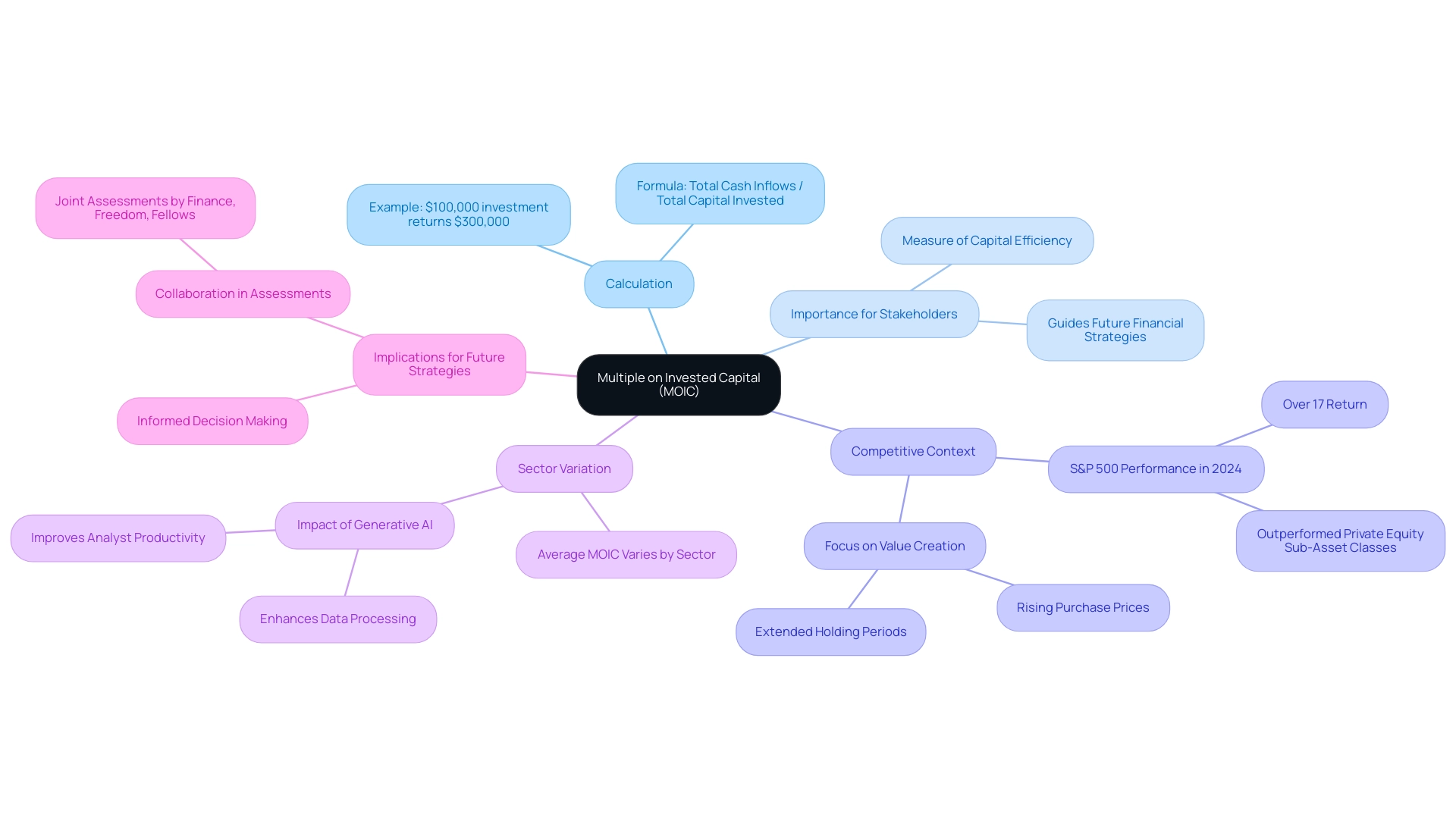
Calculating MOIC: The Essential Formula and Steps
Determining the Multiple on Invested Capital is an essential ability for technology financiers who are striving to assess their financial performance effectively. We understand that navigating this complex landscape can be challenging, but grasping how to calculate MOIC is crucial for investors, particularly in private equity, as it sheds light on the growth of initial contributions. Here’s a nurturing, step-by-step guide on how to calculate MOIC, designed to support you in mastering this important metric.
Identify Total Cash Inflows: Begin by compiling all cash inflows related to your financial commitment. This includes profits, distributions, and proceeds from any sales. We recognize that accurate tracking of these inflows is essential for knowing how to calculate MOIC precisely, and it can be a daunting task.
Determine Total Capital Invested: Next, ascertain the total amount of capital you initially invested in the project. This figure serves as the baseline for understanding how to calculate MOIC in your return on investment calculation.
Apply the Formula: The fundamental formula for calculating MOIC is:
MOIC = Total Cash Inflows / Total Capital Invested
For instance, if your initial investment was $200,000 and you received $600,000 in total cash inflows, the calculation would be:
MOIC = $600,000 / $200,000 = 3.0
This indicates that you have tripled your investment—a strong indicator of positive performance.
Interpret the Result: To understand how to calculate MOIC, a MOIC of 3.0 signifies that for every dollar invested, you have generated three dollars in returns. This measure is especially beneficial in private equity, as it helps in understanding how to calculate MOIC for the expansion of initial contributions. However, it should be regarded alongside other metrics, including Internal Rate of Return (IRR) and Return on Equity (ROE), for a comprehensive evaluation of performance. We know that including both realized and unrealized values of assets in your calculation is important, as this provides a more complete picture of your performance.
Common Mistakes to Avoid: Many investors overlook the importance of including all relevant cash inflows or miscalculate the total capital invested. We empathize with those who have faced these challenges, and ensuring precision in these areas is essential for knowing how to calculate MOIC accurately, leading to a dependable financial figure.
Current Best Practices: Financial specialists advise frequently refreshing your cash inflow records and maintaining clear documentation of all financial transactions. This practice not only assists in precise computations but also demonstrates how to calculate MOIC, thereby improving your overall financial strategy.
Case Studies: In venture capital, the multiple on invested capital serves as a straightforward measure for assessing the value generated by resources. For instance, a fund that shows a multiple of invested capital of 2.5 indicates that it has returned $2.50 for every dollar invested. This can be an influential measure when comparing fund performance. This measure is utilized to assess how to calculate MOIC for the performance of a financial venture in relation to its initial expense, merging realized and unrealized values of assets, and is essential for fund due diligence.
As Mihkel Torim, a leader in the field, highlights, the club's dedication to providing members with the essential insights and resources to make informed choices emphasizes the significance of precise calculations.
By adhering to these steps and best practices, technology financiers can understand how to calculate MOIC efficiently and interpret this measure, thus improving their decision-making process in the evolving environment of private markets.
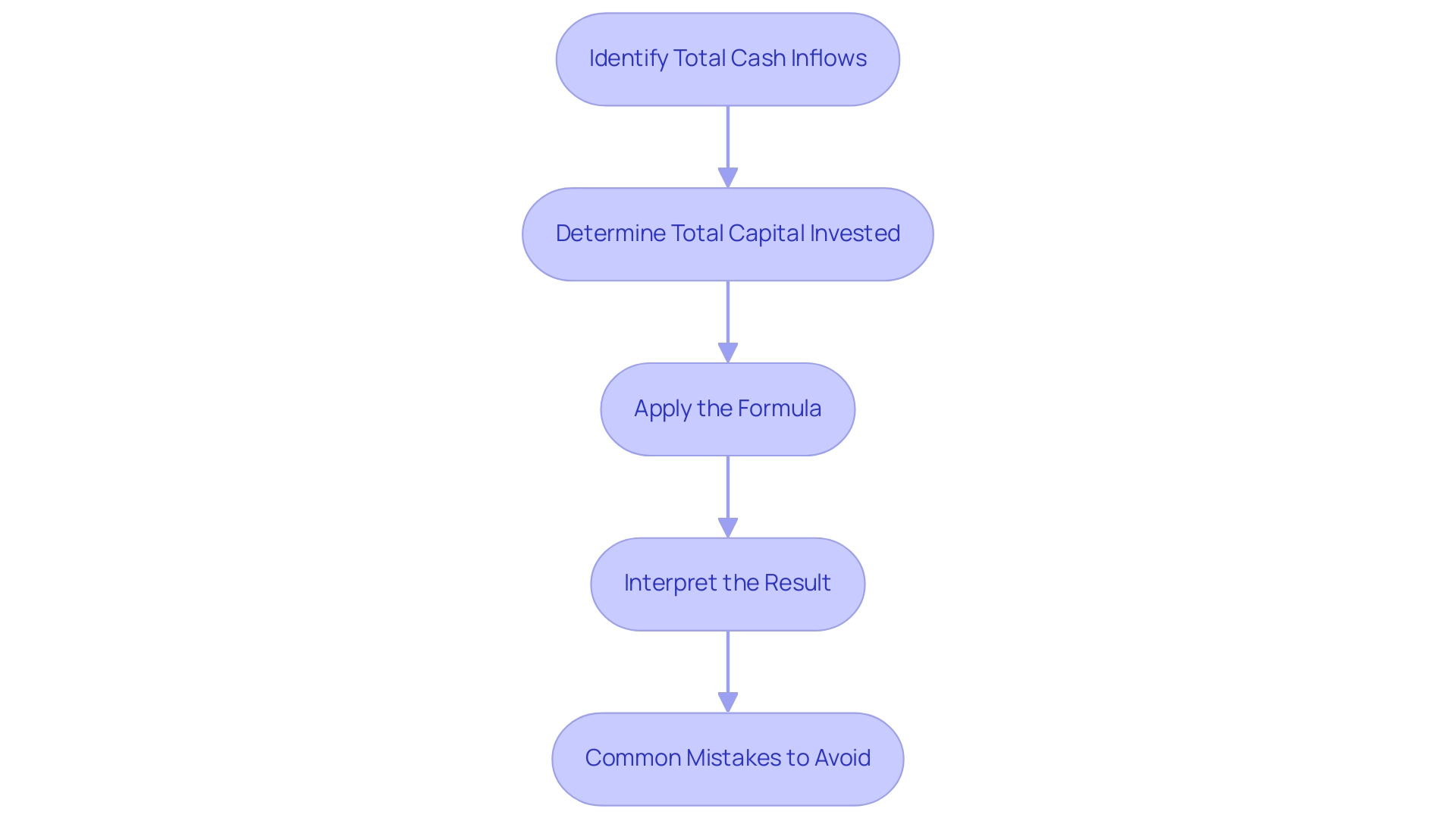
The Importance of MOIC in Private Equity Investments
Multiple on Invested Capital serves as a vital measure in private equity, guiding investors on how to calculate MOIC in relation to the returns generated from the capital utilized. We understand that this metric is essential for evaluating financial strategies and allows for meaningful comparisons across various opportunities. A higher multiple on invested capital typically signifies a more successful financial commitment, while a lower multiple may indicate potential underperformance, which can be concerning for many investors.
As we look ahead to 2025, the significance of multiple on invested capital has become even more pronounced, particularly as private equity firms navigate a complex landscape marked by fluctuating deal volumes and values. Many of our members have experienced the challenges of significant variations in the private equity sector, especially during difficult years such as 2008, 2009, and 2020, where 32%, 47%, and 27% of exited deals, respectively, resulted in losses. Moreover, the total transaction volume and worth in Europe have exhibited variations, underscoring the importance for stakeholders to understand how to calculate MOIC to evaluate fund performance and make knowledgeable choices regarding future funding.
Expert insights reveal that knowing how to calculate MOIC efficiently can improve financial strategies. Analysts highlight that a comprehensive understanding of how to calculate MOIC not only assists in assessing past performance but also guides future financial choices, particularly in the tech sector, where swift changes can affect returns. For instance, it will be essential for stakeholders to know how to calculate MOIC, as the average MOIC for private equity funds in 2025 is projected to reflect the evolving dynamics of the market.
Insights from Baltic financial leaders like Donatas Keras, a founding partner of Practica Capital, and Kristjan Tamla, Managing Director of efTEN, further illustrate how to calculate MOIC and its significance in shaping financial strategies. Their experiences highlight the importance of community collaboration and knowledge sharing in navigating the complexities of venture capital and real estate ventures. By concentrating on how to calculate MOIC, investors can gain insights into the value generated by their financial contributions, enabling them to adjust their strategies proactively.
The commitment to inclusivity, as championed by Finance, Freedom, Fellows' founder, Akim Arhipov, reinforces the belief that financial superpowers should be accessible to everyone. This community-driven approach not only fosters collaboration but also empowers members to co-invest and learn from one another, ultimately driving meaningful outcomes in the ever-evolving tech market. By incorporating this measure into their financial strategies, members of Finance, Freedom, Fellows can enhance their comprehension and usage of how to calculate MOIC, which is an essential indicator that further aids their success in finance.
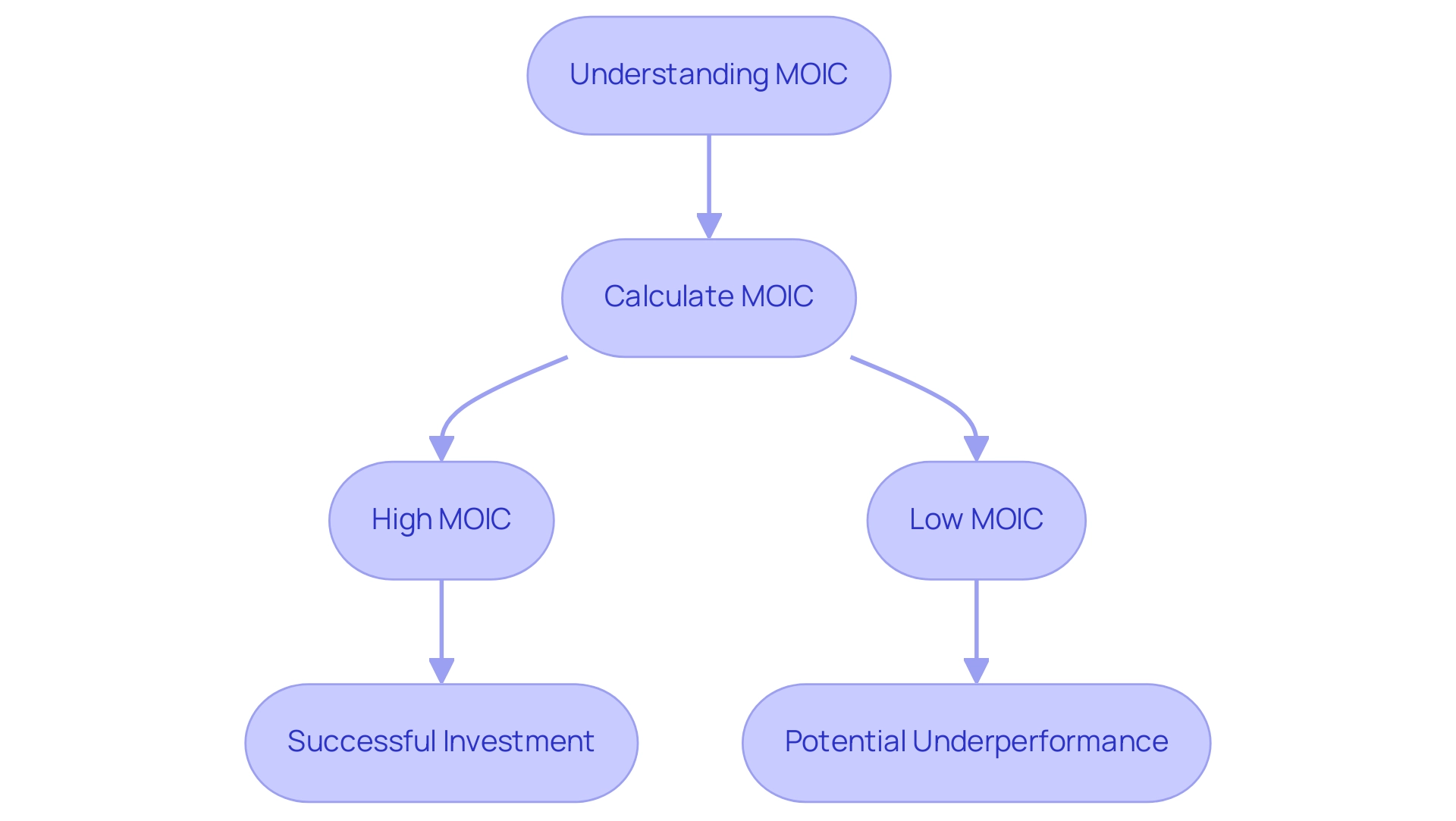
MOIC vs. Other Key Investment Metrics: A Comparative Analysis
When evaluating investments, it’s important to understand the distinctions between key performance metrics such as MOIC, IRR, and TVPI. These concepts can feel overwhelming, but grasping them is crucial for making informed decisions that truly reflect your financial journey.
-
Internal Rate of Return (IRR): MOIC, or Multiple on Invested Capital, quantifies the total return on investment, while IRR incorporates the time value of money, presenting a percentage return over a specified period. This makes IRR particularly valuable for assessing capital efficiency across varying timeframes. Many of our members have shared how understanding this metric has helped them gauge how quickly their assets are generating returns, providing them with peace of mind.
-
Total Value to Paid-In Capital (TVPI): TVPI offers a broader perspective by assessing the total value of a venture against the capital contributed, including both realized and unrealized gains. Unlike MOIC, which focuses exclusively on cash inflows, TVPI helps paint a fuller picture of an asset's overall performance, making it essential for understanding the complete scope of returns.
In 2025, performance indicators reveal that median EBITDA and revenue compound annual growth rates for realized private equity firms have surpassed 11%, nearly double that of public companies. This statistic underscores the importance of using various measurements to assess financial performance effectively. We understand that navigating these figures can be daunting, especially when considering the benchmark S&P 500, which returned over 17 percent in 2024, highlighting the competitive landscape between private equity and public markets.
The evolution of the private equity market, as noted by Cambridge Associates, emphasizes a shift towards building better businesses with a focus on top-line growth. This evolution is crucial for understanding how to calculate MOIC, as well as its significance alongside IRR and TVPI in financial analysis. A case study titled 'Evolution of the US Private Equity Market' illustrates how private equity strategies have adapted, leading to stronger performance indicators and a greater emphasis on operational enhancements.
By grasping these differences, stakeholders can learn how to calculate MOIC in conjunction with IRR and TVPI to develop a more nuanced understanding of their financial outcomes. For instance, a case study analyzing technology allocations in 2025 demonstrates how merging these measures can lead to more informed decision-making. As many of our members have experienced, this is especially vital in a market where private equity has progressed to highlight top-line growth and operational enhancements. As Akim Arhipov, creator of fff.club, asserts, 'Financial superpowers should be available to all,' emphasizing the importance of comprehending and applying these financial indicators to empower every investor.
This multifaceted approach not only enhances financial strategies but also aligns with the growing sophistication of the private equity landscape. Companies are increasingly outperforming public market counterparts in revenue growth and margins, and we’re here to support you in navigating these changes with confidence.
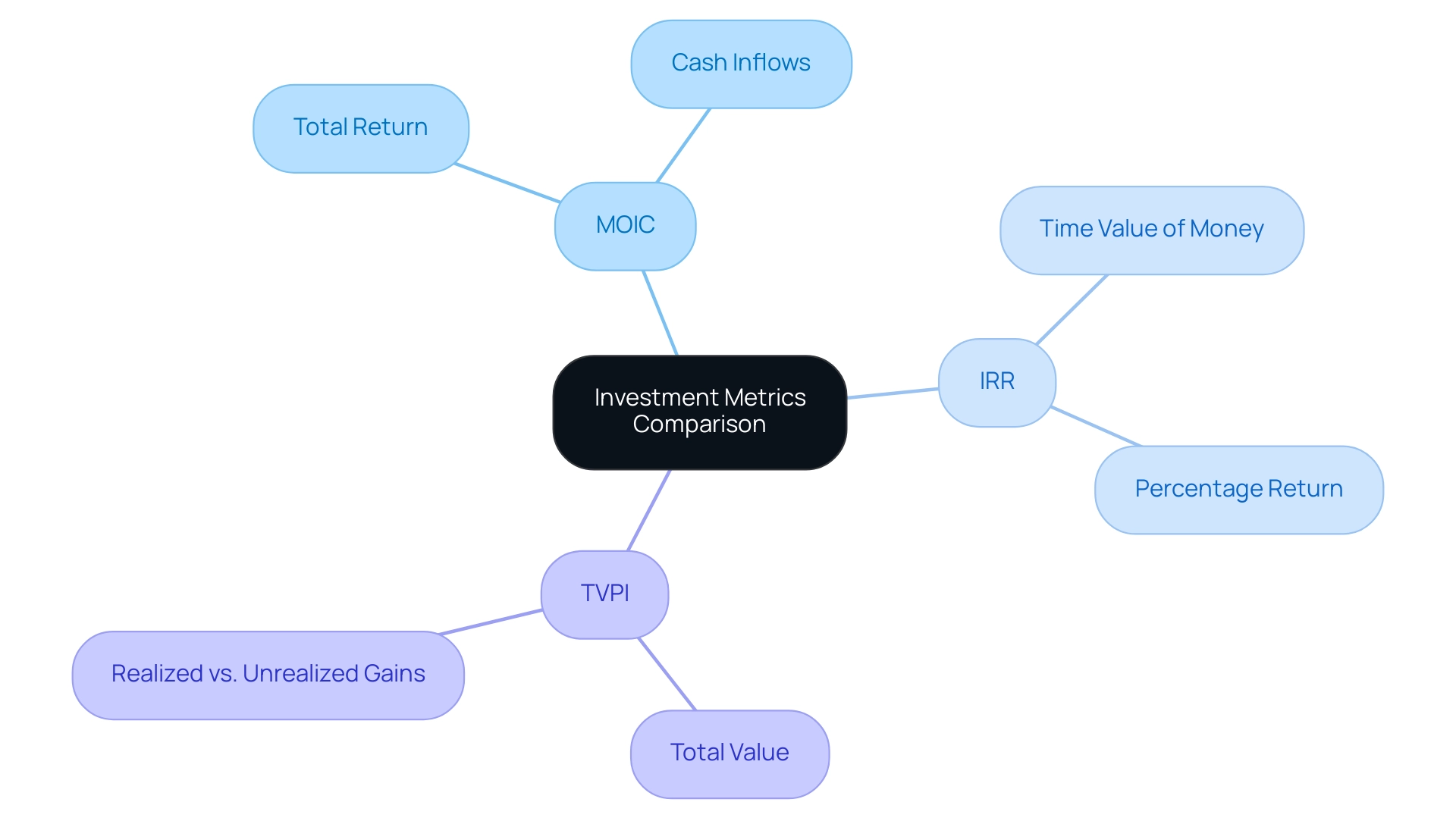
Limitations and Challenges of Using MOIC in Investment Analysis
While the Multiple on Invested Capital (MOIC) serves as a useful metric for evaluating investment performance, it is essential to recognize its limitations, which many investors may find concerning:
-
Ignores Time Value of Money: This measure often overlooks the timing of cash flows, a critical factor that can significantly affect overall returns. For instance, a financial commitment that returns 3.0x after five years may not feel as appealing as one that returns 2.0x in just two years. This highlights the importance of considering when returns are realized, a sentiment echoed by many in our community who have navigated similar situations.
-
Lacks Context: A high multiple of invested capital figure can be misleading if it doesn’t reflect the duration of capital commitment. A financial commitment achieving a 3.0x return over an extended period may not be as successful as one that achieves a lower return in a shorter timeframe. This emphasizes the need for contextual analysis, a lesson that resonates deeply with those who have faced similar challenges.
-
Potential for Misinterpretation: It’s easy for investors to mistakenly view a high multiple on invested capital as a reliable indicator of future performance. This misinterpretation can lead to suboptimal financial decisions, as past performance does not guarantee future results. Being aware of this pitfall is crucial for informed decision-making. As Mike Hinckley, Founder of Growth Equity Interview Guide, wisely states, "Only by applying this strategy efficiently can stakeholders make more informed choices and enhance their portfolio strategies."
-
Does Not Reflect Risk: MOIC does not incorporate the inherent risks associated with a financial commitment. Understanding the risk profile is essential for those putting their money in, as it can significantly affect the potential for returns. Without this consideration, individuals may overlook essential elements that could impact their financial results.
To navigate these challenges effectively, we encourage stakeholders to learn how to calculate MOIC alongside other financial metrics, such as Internal Rate of Return (IRR) and Attribution Analysis. This comprehensive approach enables a more nuanced understanding of financial performance and enhances decision-making capabilities in the complex landscape of private markets. As the trend towards robust GP Alpha analysis continues, many anticipate that attribution analysis will become increasingly common, further strengthening confidence in evaluations.
Moreover, the community involvement and education highlighted by Finance, Freedom, Fellows demonstrates how cooperation among more than 400 technology backers can aid in comprehending and interpreting multiple on invested capital effectively. This collaboration ultimately improves the investment experience. By leveraging the resources and shared knowledge available through Finance, Freedom, Fellows, individuals can better address the constraints of multiple on invested capital and make more informed decisions, fostering a supportive and informed investment community.
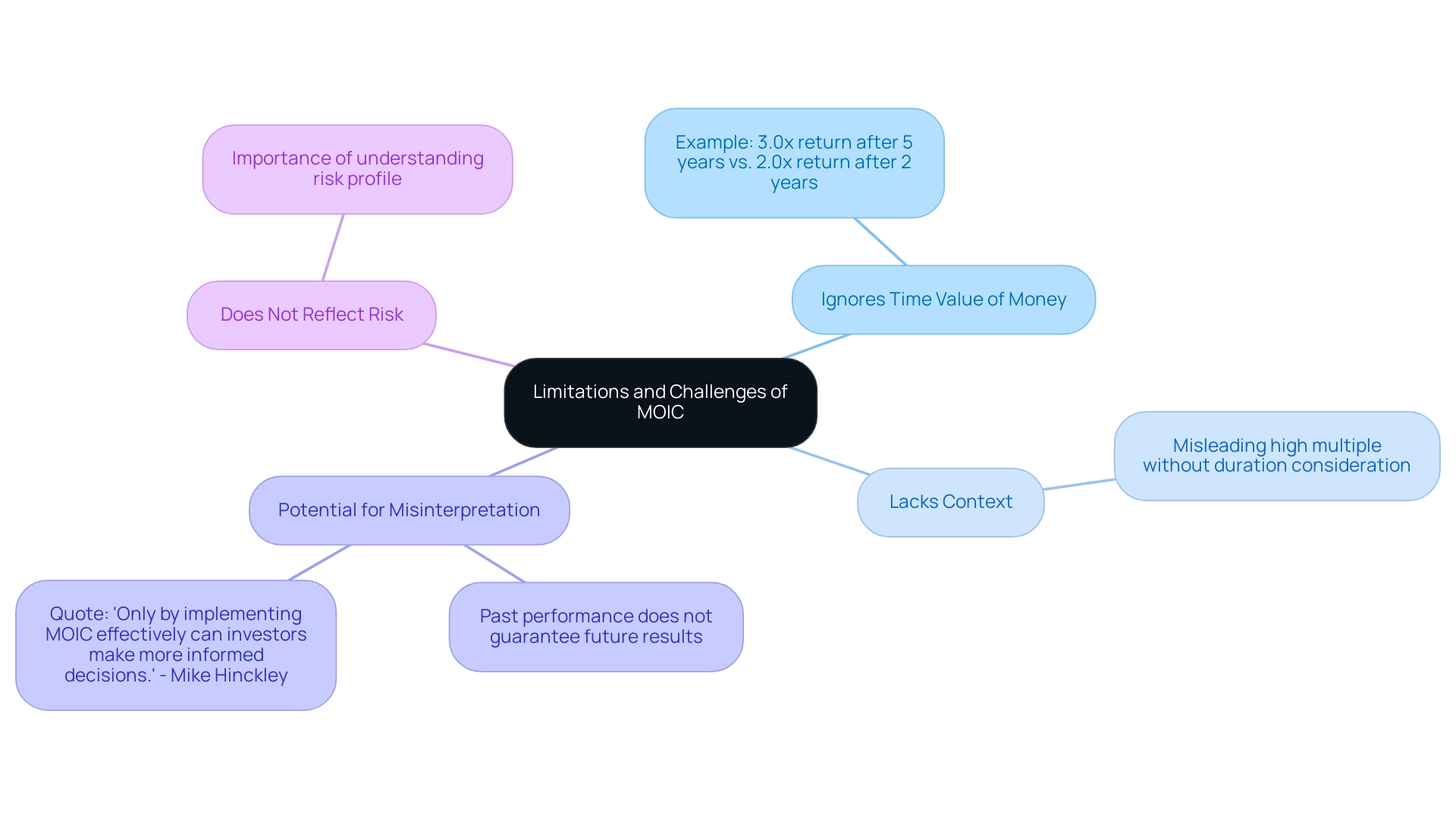
Real-World Examples: Applying MOIC Calculations
To demonstrate the application of the metric, let’s reflect on a couple of scenarios that many investors might find relatable:
-
Scenario 1: Imagine a financier who invests $500,000 into a tech startup. After five years, this startup is acquired for $2 million. The calculation of MOIC here is quite revealing:
- Total Cash Inflows = $2,000,000
- Total Capital Invested = $500,000
- MOIC = $2,000,000 / $500,000 = 4.0 (which shows the investment has quadrupled).
-
Scenario 2: Consider another financier who commits $1 million to a real estate project. Over three years, they earn $300,000 in rental income and later sell the property for $1.5 million. The MOIC calculation would be:
- Total Cash Inflows = $300,000 + $1,500,000 = $1,800,000
- Total Capital Invested = $1,000,000
- MOIC = $1,800,000 / $1,000,000 = 1.8 (indicating the investment returned 1.8 times the initial capital).
These examples not only illustrate how to apply the MOIC formula in various investment contexts but also highlight its practical implications for investors like you. In today’s financial landscape, where entry valuations for growth equity opportunities have surged—averaging an LTM EBITDA purchase price multiple of 18.0 times—it becomes increasingly crucial to understand how to calculate MOIC for evaluating potential returns. As many of our members have experienced, leveraging strong domain expertise and fostering relationships within the community can significantly enhance the ability to identify and seize the best opportunities in venture capital, private credit, and real estate. This ultimately drives value creation and successful exits.
By effectively utilizing this strategy, investors can navigate the complexities of both tech startups and real estate ventures, ensuring they make informed decisions in a competitive market. We understand that while this measure offers a straightforward evaluation of returns, it doesn’t account for the time value of money—a critical consideration when comparing it to metrics like IRR. Furthermore, a blend of growth-adjusted valuations is proposed as the optimal method for addressing challenges, especially given the rising entry valuations in growth equity opportunities. This strategic insight can further enhance your understanding of how to calculate MOIC in investment decision-making, particularly in co-investing scenarios where collaboration with other investors can amplify returns.
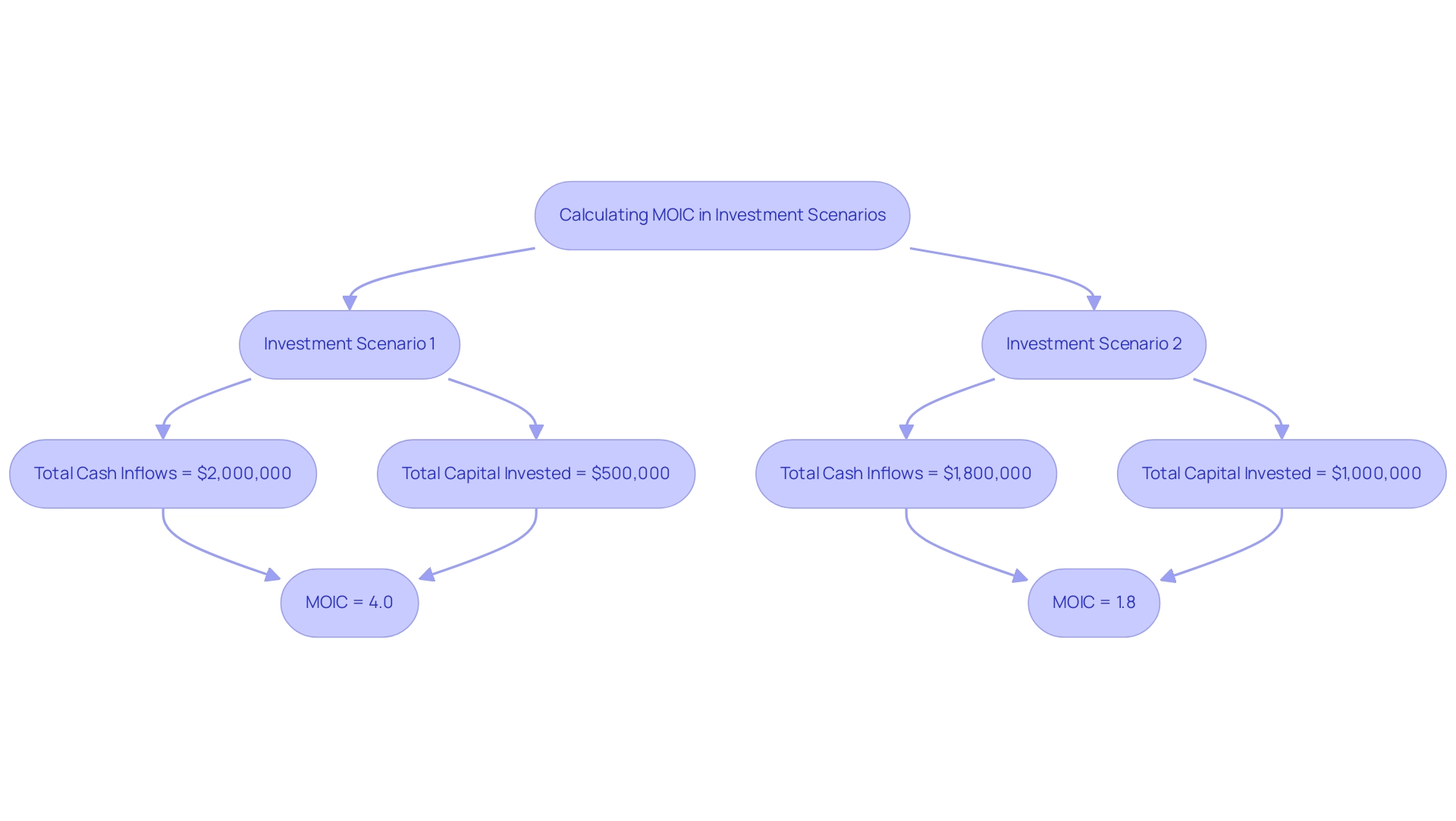
Conclusion
Understanding the Multiple on Invested Capital (MOIC) is crucial for investors navigating the complexities of today's financial landscape. We recognize that this metric not only provides a straightforward calculation of investment performance but also serves as an essential tool for assessing the effectiveness of capital deployment across various sectors, particularly in private equity and technology. By calculating MOIC, investors can gain valuable insights into their returns, allowing for more informed decision-making in an increasingly competitive market.
However, we understand that there are limitations to MOIC, including its failure to consider the time value of money and the potential for misinterpretation of results. As many of our members have experienced, relying solely on this metric can lead to challenges. To mitigate these issues, we encourage investors to utilize MOIC in conjunction with other key performance metrics, such as Internal Rate of Return (IRR) and Total Value to Paid-In Capital (TVPI). This multifaceted approach enables a more comprehensive evaluation of investment performance, ensuring that all relevant factors are taken into account.
As the investment landscape continues to evolve, staying informed about the trends and applications of MOIC will be essential for achieving sustained financial success. By leveraging the insights and resources available through collaborative communities like Finance, Freedom, Fellows, we can enhance our understanding of MOIC, optimize our strategies, and ultimately drive better investment outcomes. Embracing this metric as part of a broader analytical framework will empower us to navigate the complexities of the market with confidence and precision, fostering a sense of community and support among investors.



